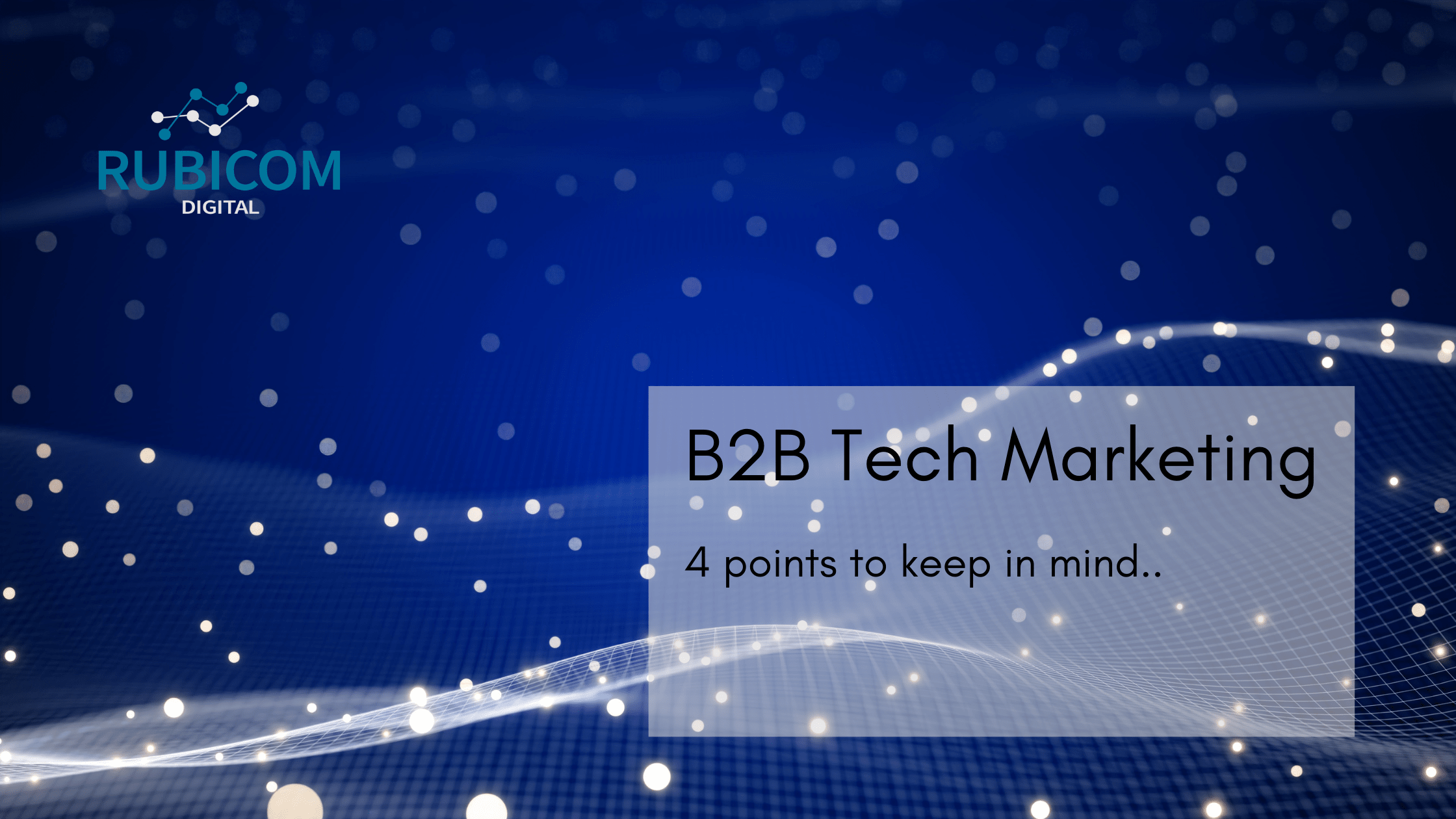Building a B2B Technology Company Marketing Strategy
The future is being driven by technology, and a technology company marketing strategy plays a major role in the growth of technology companies. With technology being the driving force of the future, it comes with a great deal of competition and no shortage of solutions out there for customers to choose from.
How will your technology company marketing strategy set you apart? This post is going to break down 4 points that have shaped out the last 5+ years of marketing in the tech world. From understanding your audience to cleaning up your company messaging, we’ve got you covered.
We’ll go through how it differs from other industries including:
- Niche audience with different goals (IT Manager vs. IT Director vs. VP of IT)
- Channels to focus on
- Focus on the solution, not the product
- Simplicity in messaging, don’t get cute with value props
Understanding Your Audience
It goes without saying that you have to understand who your audience is, but in the tech world this is taken a step further.
If you’re a technology company, then you’re marketing directly to technology peers at other companies. One thing to keep in mind is that not all tech leaders have the same goals in mind;
Here’s what we mean:
- Systems Administrators: Admins care about the technology and ensuring it works. After all, they’re the ones that have to work with it on a daily basis. With that in mind, they certainly don’t care about budgets and total cost of ownership.
- IT Managers: Managers care about their administrators being productive and completing projects (internally and externally) on time. If you’re marketing to the managers, make sure to highlight how you help them accomplish one of those two goals.
- IT Directors: The higher up the chain you climb, the more that numbers start to come into play. Director levels care not just about the technology and employee efficiency, but are also responsible for the budgeting discussions. They long miss the days of being the admin and working with the technology directly, all without worrying about keeping costs in line.
- VP Level and up: At this level of the chain, the bosses are a bit less technical and their role is to manage their team and keep ownership happy. It’s best to not get too cute with buzzwords here and get straight to the point. How does your solution make them look better to ownership and keep their employees productive?
Keep in mind that not all of these titles directly reflect how each works within an organization, but are more so meant to highlight the difference in roles, and that the same marketing message will not apply to each.
Identify who you’re targeting and what they care about; Then draft your marketing message to them.
Channels to Focus on
Some channels are more impactful than others depending on who your target audience is. In the B2B world, here are some of the channels you should be looking at.
To touch on some statistics from a Social Media Strategies Summit study:
- 94% of B2B marketers use LinkedIn for content marketing
- 89% of B2B marketers turn to LinkedIn for lead generation
- 70% of salespeople say they’re most active on LinkedIn
This isn’t to say that other social media channels don’t work in the B2B space, but rather that LinkedIn is the most used social channel. You can take this in a few different ways:
- Ride the wave with the rest of marketers
- Differentiate by using different social channels that aren’t as targeted
- A combination of 1 & 2
As you run your campaigns and leverage the different channels, you’ll quickly notice what is and isn’t working for you, and then be able to adapt accordingly.
Google Search/Google Ads
According to Google, 89% of searchers use the internet in the B2B world to come up with more information.
This means that you should be leveraging:
- Search Engine Optimization for organic search results
- Paid ads to generate more traffic and short-term wins
Paid ads and organic search complement each other so well because one is meant to generate short term wins (paid ads) while the other (organic search/seo) is meant to produce results over the long term without having to pump a bunch of money into advertising.
For example, if searching for a ‘data backup and replication’ solution, the company Veeam has top positions in paid advertising AND organic search; This will surely lead to more clicks and customers.
31% of marketers cite email as their top revenue generating channel. Finding a way to effectively leverage email marketing to complement your other channels can help you generate leads with automated campaigns.
As an impactful outbound tactic, email marketing will complement your Search and Content marketing efforts as you seek to reach your end users directly.
We’ll later discuss simplicity in messaging and show a real-life example of an email that generated great results, but for now understanding the importance of email in your B2B technology company marketing strategy is key.
Here’s how to build a marketing email that gets opened.
Content Marketing
This will go hand-in-hand with your SEO/Google Search efforts as you seek to generate high quality content to inform users. In the digital marketing era, your target knows what they’re looking for and will come to you often before you reach them.
Content marketing plays a massive role for inbound marketing and the ability to bring users to your business by simply informing. Here’s how to build a content marketing structure.
According to Convince and Convert, 70% of people would rather learn something via an article or blog post rather than a paid advertisement. Digital content includes but isn’t limited to:
- Blogs
- Podcasts
- Videos
- Infographics
- Case studies
- White papers
Seek to inform your audience, and they’ll come to you.
Focus on The Solution, Not The Product
Starting around 2018, the term ‘digital transformation’ became a popular buzzword in the technology industry. Many organizations built out their B2B technology company marketing strategy focused on the term ‘digital transformation’; What does that even mean?
Customers were wondering the same thing. For a specific client, a campaign was run titled ‘Digital Transformation: What Does That Even Mean?’; The campaign resulted in $300K in pipeline in the 3rd quarter of that given year alone.
Why?
- A focus on the solution, not the product: The solution was building out a roadmap for customers that included upgraded hardware to meet changing business demands as companies grew.
- Highlight the issue, not the product: The campaign didn’t state that the newest Dell EMC Unity was the best product out there, but that outdated hardware would surely create a compatibility hassle that would make the future challenging, the product was a subset to help solve that problem.
- Clear messaging: Lastly, the campaign didn’t focus on buzzwords like ‘next-generation’ and ‘digital transformation’. The campaign focused on showing a future scenario that the customer could envision, and a scenario that would make their jobs as an IT professional difficult in the years to come; the choice was theirs.
When you focus on telling a story about how the solution can address a current/future problem, you’re likely to be able to better communicate with your targeted customers in a way that buzzwords and industry fluff just can’t compete with.
Simplicity in Messaging
Now after the last section, you’re probably curious as to what the messaging looks like that can generate $300K in pipeline during a single quarter; It’s probably not what you expect.
Marketers get paid tens of thousands (if not hundreds) of dollars on an annual basis to create messaging that resonates with an audience. That comes with high expectations and fancy words that IT executives frankly don’t care to read.
Be clear, concise, and get directly to the point.
Here’s how.
Digital Transformation is the example of a buzzword.
An email was crafted stating:
“Digital transformation is industry fluff that really means, create a roadmap for the future and upgrade your tech to keep up with growth. Here’s how we do that:
- An understanding of what your future business looks like so you can plan accordingly
- Hardware that leverages automation so your IT admins don’t waste time on mundane tasks
- A converged infrastructure that cuts down on rack space and lowers ownership costs
Let us know if this is something you’d find valuable.”
The results showed that IT executives resonated with the messaging. One of the clear reasons why is that it gets to the point, outlines a future path for them, and is written in plain English. Nothing too cute.
This example was crafted through the email marketing channel, but the underlying concept applies to all channels.
Not All Industries Are Created Equally
Keep in mind that this was created solely for a B2B Technology Marketing Strategy, but the overall goal is the same.
Keep it simple, you’re speaking to another human on the other end of that screen.
Know who your target audience is, how you’re going to reach that target, what your solution is, and how to frame that solution.
Once you go through this process, analyze what has worked well and what has room for improvement.
You’ll notice that some job titles are more responsive to certain messaging, if so then why?
One email will generate more engagement than others, how was that one better than the rest?
Even more importantly, which channels are generating the most pipeline for your business?
Let us know how you’re working through these challenges or if you’re just getting started and want to book a consultation.

Gary McConnell Co-founded Rubicom Digital in 2019 with a goal of providing digital marketing consulting services in the B2B space.
Gary continues to serve as the Marketing Director of a Data Center-focused IT Provider, VirtuIT Systems.

